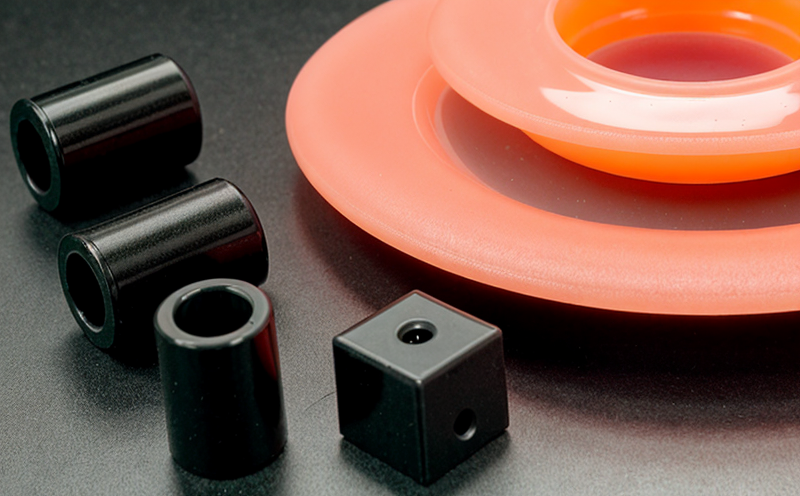EN 13613 Skateboard Ramp Plastic Surface Testing
The EN 13613:2005 standard provides comprehensive guidelines for evaluating the physical and mechanical properties of plastic surfaces used in skateboard ramps. This test is crucial for ensuring that materials meet the necessary durability, safety, and performance criteria required by manufacturers, quality managers, compliance officers, and R&D engineers.
Skateboard ramp plastics are subjected to a variety of environmental factors including abrasion, impact, weathering, and chemical exposure. These conditions can significantly affect the integrity and longevity of the plastic surface. The EN 13613 test aims to assess how well these materials perform under real-world conditions while adhering to strict international standards.
One key aspect of this testing is the abrasion resistance of the plastic surfaces. This involves simulating wear and tear over time using an abrasive wheel or similar apparatus, which helps determine the surface's ability to withstand continuous friction without degradation. Another important factor is impact strength, measured by dropping weights onto samples from various heights to gauge their resilience against blunt force impacts.
Weathering resistance tests evaluate how well the plastic handles exposure to sunlight, temperature fluctuations, and moisture. This ensures that the material remains stable even in harsh outdoor environments where skateboard ramps are often installed. Additionally, chemical stability is tested by exposing specimens to different solvents and acids commonly found on skateboards or within skate parks.
For quality managers and compliance officers involved with this type of project, understanding these tests is essential for ensuring product safety and meeting regulatory requirements. R&D engineers can benefit from knowing the specific parameters needed when developing new materials or improving existing ones. Procurement teams will find value in selecting suppliers who meet these rigorous standards.
When preparing samples for EN 13613 testing, it's important to follow precise procedures outlined in the standard. Samples should be cut into standard dimensions and conditioned according to specified temperature and humidity levels before beginning any tests. It is also advisable to consult with experienced laboratory personnel who specialize in this area of expertise.
The results from these tests play a critical role in determining whether skateboards ramps can safely accommodate riders while maintaining their structural integrity over extended periods of use. By adhering strictly to the EN 13613 requirements, manufacturers demonstrate commitment to producing high-quality products that meet both consumer expectations and regulatory standards.
Understanding and implementing the principles behind this test not only enhances product performance but also contributes positively towards overall safety within skate parks and public spaces where such equipment is used regularly. Through rigorous evaluation processes like those prescribed by EN 13613, stakeholders can trust that they are investing in reliable materials capable of enduring demanding conditions without compromising rider experience or endangering user health.
Applied Standards
| Standard | Description |
|---|---|
| EN 13613:2005 | This European standard specifies the methods for determining the physical and mechanical properties of plastic surfaces used in skateboard ramps, including abrasion resistance, impact strength, weathering resistance, and chemical stability. |
| ISO 4649-1:2018 | An internationally recognized method for measuring the wear behavior of materials under controlled conditions, applicable here for simulating real-world abrasion scenarios on plastic surfaces. |
Scope and Methodology
| Test Parameter | Description |
|---|---|
| Abrasion Resistance | Measures the ability of a plastic surface to resist wear caused by frictional forces during prolonged use. |
| Impact Strength | Evaluates how well the material withstands sudden impacts without failing or deforming excessively. |
| Weathering Resistance | Assesses the stability of the plastic surface when exposed to natural elements like sunlight and temperature variations over time. |
| Chemical Stability | Determines whether the material maintains its properties after being subjected to various chemicals used in skateboards or found within skate parks. |
The EN 13613 test begins with sample preparation, which involves cutting specimens into standardized sizes and conditioning them according to specified environmental conditions. Once prepared, the samples undergo multiple stages of testing:
- Abrasion Resistance Test: This uses an abrasive wheel rotating at a controlled speed over the surface of the plastic specimen for a predetermined period.
- Impact Strength Test: Specimens are dropped from varying heights onto a metal anvil, measuring both the number of impacts before failure occurs and the energy absorbed during each impact.
- Weathering Resistance Test: Samples are exposed to artificial light sources that mimic sunlight exposure for extended periods. Simultaneously, temperature cycling is applied to simulate seasonal changes in climate.
- Chemical Stability Test: Specimens are immersed in different solvents and acids representing typical substances encountered on skateboards or within skate parks.
The results of these tests provide valuable insights into the performance characteristics of skateboard ramp plastics. Compliance with EN 13613 ensures that materials used meet strict safety and quality standards, thereby enhancing rider safety and satisfaction in skate parks around the world.
Quality and Reliability Assurance
Ensuring consistent quality throughout the production process is paramount for manufacturers of skateboard ramps. Implementing robust quality assurance measures during material selection, manufacturing, and final inspection helps maintain compliance with EN 13613 standards.
Material Selection: Careful evaluation of raw materials ensures they possess the necessary properties required by the standard. Suppliers must provide certifications confirming adherence to relevant specifications.
Manufacturing Process: Strict adherence to manufacturing protocols guarantees that each step adheres closely to prescribed guidelines. Regular audits help identify potential deviations early on, allowing for corrective actions promptly.
Final Inspection: Thorough examination of every completed skateboard ramp ensures all components meet the specified criteria before shipment or installation. Non-conforming items are corrected immediately or rejected entirely.
By integrating these quality assurance practices into their operations, manufacturers demonstrate dedication to producing reliable products that not only comply with EN 13613 but also exceed customer expectations in terms of performance and safety.





